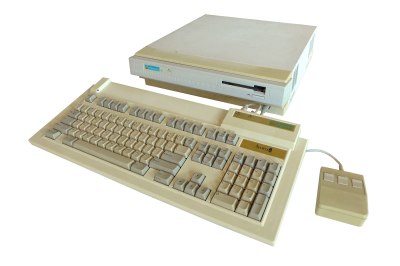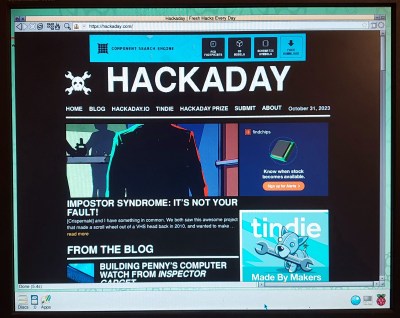On a mundane day at some point in late 1987, though I didn’t grasp exactly what it would become at the time, I sat in front of the future. My school had a lab full of BBC Micros which I’d spent the previous few years getting to know, but on that day there was a new machine in one corner. It was a brand-new Acorn Archimedes, probably an A300, and it was the first time I had used an operating system with a desktop GUI. The computer was the first consumer application of the ARM processor architecture which has since gone on to conquer the world, and the operating system was called Arthur, which hasn’t. That’s not to say that Arthur is forgotten though, because it was soon renamed as RiscOS, managed to outlive both Acorn and the Archimedes, and still survives as a maintained though admittedly niche operating system to this day. So my Daily Driver this month is the current generation of RiscOS, version 5.28, and the machine I’m running it on is a Raspberry Pi 4. For a computer with an ARM core that’s designed and sold by a company based in Cambridge just like the original Acorn, it’s the most appropriate pairing I can think of.
Probably the Smallest OS In This Series

At one point the Raspberry Pi folks even featured the Pi version of RiscOS on their website, but for those missing it there it’s freely downloadable as a disk image from the RiscOS Open site. Having spent most of its life as a closed-source product it’s been opened up over the last decade, and you can grab the source if you’re interested. When it’s normal for an OS download to run into the many gigabytes, it’s a bit of a shock to grab one that’s a shade under 140 megabytes and can be written to a 2 gigabyte SD card. This makes it probably one of the quickest operating system installs I have ever done, with all steps completed in a very short time. Sticking the SD card into the Pi it boots to a desktop in about 32 seconds which is only 5 seconds less than the latest Raspberry Pi OS image, so sadly that compactness doesn’t net you any extra speed.
The desktop retains the familiar layout I remember from those early machines, but with a much more modern feel. Along the bottom is a bar with quick access icons for discs on the left and for running apps on the right, while shortcut icons for frequently used apps are on the desktop itself. It feels very much like a quirky early 1990s interface from the days before users came to expect a Windows 95 Start menu or MacOS Dock. It took me a while to figure out the middle-button context menus and how to shut it down without pulling the plug, for example. Once the initial settling-in period is over though, it’s an easy environment to use and it’s pretty intuitive. One point to remember though, networking is wired-only.
Not Quite Enough For Work

For my work I need a web browser, and for that RiscOS ships with NetSurf. It’s well known as a lightweight browser on many platforms, but it originated on this operating system and it remains probably the fastest option. It doesn’t have Javascript enabled by default, but once the option is found in the context menus it will do its best to run most modern sites. I say most modern sites though, because sadly for me one of the ones it had problems with was wordpress.com. Viewing Hackaday is fine, but thus unable to log in, sadly working on it is impossible.
For such a long-lived OS it’s not surprising that there’s plenty of software out there for RiscOS, though some of it is pretty old. This version comes bundled with both a store and a package manager, both of which have free software but the former also includes some paid packages. Searching online will provide more choices, but beware, as stuff compiled for the earlier Archimedes computers will only run on processors with the 24-bit address space. Even if you don’t want to download anything the distribution ships with a range of apps, for example besides Netsurf there’s the PipeDream office suite.
Under the hood, this remains a relatively simple operating system close to its roots. I’m told by friends who know more about these things than I do that it’s still possible for a single developer to understand the whole thing completely, so for anyone interested in such things it’s probably worth a look at the source. Meanwhile I’m left a little sad that I was thwarted by not being able to log in to WordPress.com for Hackaday, I found RiscOS to be a very usable and pleasant experience still reminiscent of all those earlier consumer GUIs. I had strong Amiga Workbench vibes at times, and if the browser was a little more capable I could see myself loading this on a Pi 400 and really using it as a daily driver. Give it a try yourself, you may come away feeling the same.

















> My windows pc’s can boot to my login and desktop In about 5 seconds
Actually, are you sure that is a fresh boot? Windows defaults to something with is more like a recovery from hibernation per default.
Resuming to the state that it was in immediately after a cold boot is indistinguishable from a cold boot. That’s still a win.
Unless, y’know, you didn’t initialize a device properly because you skipped all that waiting around in order to boot faster. Or you specifically wanted to boot a fresh session of the OS because like it or not, issues still accumulate over time.
We used to live in a society where a bios was a bios and we arranged the files necessary for boot on the outer rim of our hard drive to get the most speed. Uphill, both ways!
There was a project some years ago called ROX (RiscOS on X) that implemented a Linux desktop environment that strongly resembled the RiscOS. It’s been a dead project for a long time, sadly. Only the filer manager really survives at this point (rox-filer) although I did use their terminal program for _many_ years. Fond memories of that one.
Rox brings some memories. To be honest I never liked its desktop environment, but its blazing fast rox-filer has been my default file manager for long years when I wanted a snappier experience than my then PC could offer using Gnome or KDE stuff. Yep, it’s a lot faster than XFCE’s Thunar too.
Congratulations for at least mentioning the Elephant in the room when it comes to this OS.
In the last sentence of paragraph 3, you state that “networking is wired-only”.
Can someone please explain why this OS does not have wireless connectivity ?
Because it’s changed very little since the 90s due to having an ever dwindling user base, and even smaller developer base. All major developments are done using bounty donation payments from the community. The bigger elephant in the room is a complete lack of 64-bit ARM support. RISC OS will not run on the current Raspberry Pi generation. It’s doesn’t support unicode either. To quote the RISC OS Open site: “Our network stack dates back to 1997, and the Internet is a lot bigger and scarier than it was back then. Twenty years on and it’s time to bring it in-line with modern usage and security requirements. Step 1 shores up some security issues, and in this second part we want the bounty hunter to dig new foundations based on the latest FreeBSD stack, on top of which the final 2 bounties will build WiFi connectivity and a larger IPv6 address space.” Step 2 is currently underway, with funding currently being sought for step 3.
I guess the simplest way to say it is a barebones IP and Ethernet stack is much smaller than an IP and Wireless Ethernet stack. Of course Wireless Ethernet has only gotten bigger over the years. To my experience there are configurable hardware devices for converting a simple wired ethernet connection to modern-ish wireless ethernet connection.
Is that true? I thought the only actual difference between wired and wireless networking was the protocol for establishing a connection, which today is being done by 8-bit microcontrollers with just a few kB of memory.
More like they do not have device driver support for any WiFi chipsets. Nothing to do with IP or Ethernet stack.
I’ve seen references to folks using an RPI Wifi hat, or USB network dongles to get Wifi, but never tried it.
As elephants go, this is not a major one. You can use a Raspberry Pi 1B (or pretty much any SBC with Ethernet) and a WiFi dongle to make a WiFi-Ethernet bridge. Or a Pi Zero W and an Ethernet dongle, whichever works out easier. But like I said, I’ve seen (haven’t done it myself) 8-bit computers that can do the bridge thing as well. And of course you can also do it without even Ethernet if you use PPP over a fast serial port. So maybe a Pi Pico W, to make it ultra-cheap, if not blazing fast.
*26 bit, not 24-bit. Early ARM processors used a 26-bit address space. From StrongARM onwards, 32-bit became available, but some older programs needed patching or rewriting to cope with the newer architecture.
Mostly correct, but I think 32-bit became available with ARMv3 (not ARM3) on the ARM610: the flags bits (NVCZ[IRQ][FIQ]) were moved out of the PC, into their own register, which gave it an extra 6-bits. Handily, because PC was always word-aligned, the bottom 2 bits were then used to implement Thumb mode.
I like the Windows 3.0 look of it. ^^
Hmm… I can see Win 3x in the window decorations. Having a task bar at the bottom though… still seems more like 95 to me. I would imagine some early demo of Win95 tech, still inheriting 3.x’s style looking like that.
Although note that RISC OS came out near a decade before Win95, and several years before Windows 3.0 was released.
If by “Windows 3.0 look”, you mean, square corners and icons with limited color palettes, that’s pretty much any GUI from the 80s that expected to have a color monitor. There’s hardly a competition for who thought of it first.
Workbench and GEOS didn’t look like that, though. :(
>My windows pc’s can boot to my login and desktop In about 5 seconds
Is your Windows PC a Raspberry Pi 4? If it’s not, this is not really a useful data point.
Windows also likes to display a desktop before it can do any useful work, so it’s not an accurate benchmark. You really need to start an application (in both systems) to determine that it’s really booted.
Having said that, 32 seconds does sound dreadful by RiscOS standards. Does anyone remember how long it took to boot an Archimedes or Risc PC ? I’m not sure whether to blame loading from the SD card (RiscOS 3 ran directly – no copies – from ROM), or the initialisation time of the base applications.
That sounds like you’ve got Windows Fastboot enabled somewhere? That’s where it’s actually ‘pre booted’ and a bit like coming out of hibernation without you knowing. Fresh boots of Windows, even from fast SSDs, take longer than 5 seconds in my experience.
At the BBC we used lots of RISC PCs running RISC OS for studio control and automation (from Omnibus Systems) in the 90s and 00s. The speed of rebooting a RISC PC compared to a contemporary Windows NT PC was like night and day – RISC PCs were great in that application.
I’ve used Omnibus too, well into the 00’s. The RiscPCs used as terminals were so sought after for spares, Omnibus took them back from us when their replacement system was installed.
For reference, the RiscOS based Omnibus was a media database and machine control system. The media was stored on dedicated video severs; ours were GVG Profiles. Omnibus even controlled a tape robot and out play out/presentation video switcher, running an event schedule/traffic list.
I mentioned the user interface terminals were RiscPCs, which would boot all the way to Omnibus. I’m not sure what systems were used for machine control when LAN wasn’t an option. E.g if you had access to a tape deck, what hosted the RS-422 interface for Omnibus.
Block of ice to beef bourguignon in 8 seconds.
Still got a 310 in the garage… one day I’ll get round to seeing if it still boots…
There’s a strong danger that the 10MB hard drive will have bitten the dust. A direct replacement isn’t practical (as it used an ESDI-like interface, iirc) but there are some modern IDE interfaces that will plug into a backplane and let you use a CompactFlash card as a hard drive instead.
The A3xx range were lucky in having their CMOS backup batteries mounted off-board, so any battery leakage won’t have affected the mainboard. The A3000 and later systems had them soldered to the board, and can require a bit of delicate repair to get them back to life after a few decades of battery leakage eating away at tracks and components.
ST-506. Yes, it’s a little like ESDI but pretty well known in its own right as it was the basic hard disc in any PC before IDE drives were a thing.
Yay! I remember these things! Massive improvement the BBC micros, though our school never had enough of them to use them effectively.
I was torn on them – the OS and apps felt basic to me because I was a lucky blighter whose dad brought an Apple SE home at the weekend. But colour! Colour! COLOUR! That definitely beat the 9” toaster screen on the mac.
I don’t recall them being easily programmed either – BBCs were, which was great, and were also almost completely impervious to user error (or even malice!) as they wiped when you hit that break key. Which was good when you were learning to program and then to POKE hand-assembled machine code into RAM. So many crashes!
Dan – you’re doing it the hard way! The BBC has a built-in assembler in ROM.
I’m interested to see if Jenny would try the Kolibi OS, and compare it to Risc OS, buuuut seeing that performance seems to be evaluated in terms of internet access then Kolibri OS is no contestant. Still, it’s fascinating to see the performance of these systems on modern machines.
Watch this space.
“KolibriOS s a tiny yet incredibly powerful and fast operating system. This power requires only a few megabyte disk space and 8MB of RAM to run. Kolibri features a rich set of applications that include word processor, image viewer, graphical editor, web browser and well over 30 exciting games. Full FAT12/16/32 support is implemented…
“…Have you ever dreamed of a system that boots in less than few seconds from power-on to working GUI? Applications that start instantly, immediately after clicking an icon, without annoying hourglass pointers? This speed is achieved since the core parts of KolibriOS (kernel and drivers) are written entirely in FASM (“Flat Assembler”; 80×86 family) assembly language!…”
https://kolibrios.org/en/
The reason the Pi takes so long to boot, is that the OS is loaded from a SD card. In the original A series Acorn Archimedes, the OS was in 4Mb ROM. The desktop loaded almost immediately and was ready to rock the moment the desktop appeared. For those with PC’s it is possible to load RISC OS v 5.28, via RPCemu software freely available online, this uses HostFS to store the OS and any 32bit Programs. Using either Windows or Linux system. This allows RISC OS to load in a window on either Windows or Linux desktops and allows the PC to give full WiFi networking.
You may not be aware it is actually possible to run RISC OS v5.28 on a modern PC, using a program called RPCemu available online. The ROM image is also available online.
Thus with a little bit of simple effort one can run it in a window on your PC or even full screen. It absolutely flies along and is completely useable. Even allowing WiFi networking via the PC.
Thanks for the hint! Also available for Linux, but has to be built from source (advertised as alpha-state software (0.9.4), but compiles fine on Debian, runs great). Finally I can try out the classic RiscOS versions, even Arthur!